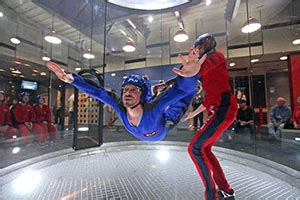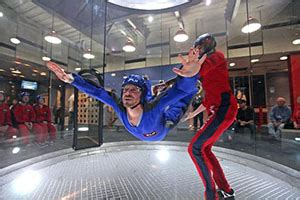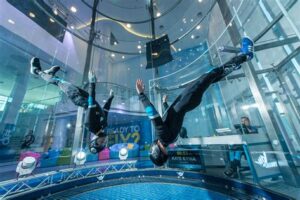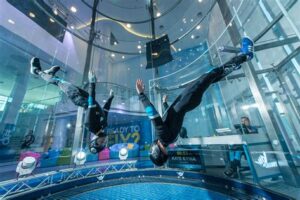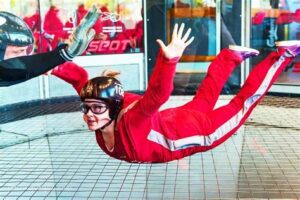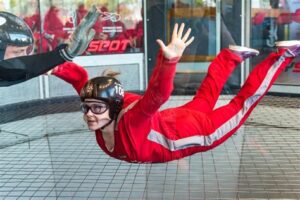Table of Contents
Experience the thrill of skydiving without jumping out of a plane! Discover the exhilaration of indoor skydiving, where you can float effortlessly in a vertical wind tunnel. Perfect for beginners and adrenaline seekers alike, practice your skills in a safe and controlled environment. Book your session now and defy gravity!
Are you a thrill-seeker looking for your next adrenaline-fueled adventure? Look no further than the exhilarating experience of indoor skydiving! Whether you are a seasoned skydiver or someone who has always dreamt of flying through the air, practicing this thrilling activity indoors provides a unique opportunity for both beginners and experts alike. So, buckle up, put on your safety gear, and get ready for an unforgettable journey into the world of indoor skydiving!
Introduction
Indoor skydiving is an exhilarating activity that allows individuals to experience the thrill of skydiving in a controlled environment. Whether you are a seasoned skydiver looking to improve your skills or a beginner wanting to try something new, indoor skydiving is a fantastic option. In this article, we will provide you with step-by-step instructions on how to practice skydiving indoors.
1. Find an Indoor Skydiving Facility
The first step is to locate a reputable indoor skydiving facility near you. Do some research online, read reviews, and check their safety record. It’s essential to choose a facility that has experienced instructors and maintains high safety standards.
2. Schedule Your Session
Once you’ve found a suitable facility, contact them to schedule your indoor skydiving session. Most facilities offer various packages, so choose one that suits your needs and budget. It’s advisable to book in advance, especially during peak times, to ensure availability.
3. Dress Appropriately
Wear comfortable, athletic clothing that allows freedom of movement. Avoid loose items such as scarves, jewelry, or hats that can get caught in the wind tunnel. You’ll be provided with a jumpsuit, helmet, goggles, and earplugs by the facility.
4. Attend the Safety Briefing
Prior to your session, you’ll attend a safety briefing conducted by an experienced instructor. Pay close attention and follow their instructions carefully. They will explain the correct body position, hand signals, and safety protocols to ensure a safe and enjoyable experience.
5. Enter the Wind Tunnel
The wind tunnel is a vertical chamber with powerful fans that create a controlled airflow. Enter the wind tunnel with your instructor’s guidance and assume the correct body position, which is typically a straight body with arms extended and legs slightly bent.
6. Maintain Proper Body Position
As you feel the wind rushing past you, it’s crucial to maintain the correct body position. Keep your head up, chin level, and back straight. Relax your muscles and let the wind support your body. The instructor will provide guidance throughout the session to help you improve your technique.
7. Practice Maneuvers
Once you are comfortable maintaining the basic body position, your instructor may introduce various maneuvers such as turns, spins, or flips. Listen carefully to their instructions and try to execute the maneuvers as accurately as possible. Don’t worry if you make mistakes; it’s all part of the learning process.
8. Gradually Increase Difficulty
As you gain confidence and proficiency, your instructor will gradually increase the difficulty level. They might introduce more advanced moves or ask you to perform specific tasks during your session. Embrace the challenge and push yourself to improve.
9. Enjoy the Experience
Indoor skydiving is not only about learning and practicing; it’s also about having fun! Enjoy the sensation of flying, the rush of adrenaline, and the feeling of weightlessness. Let go of any fears or concerns and fully immerse yourself in the experience.
10. Debrief and Reflect
After your session, you’ll have a debriefing with your instructor. They will provide feedback on your performance, highlight areas for improvement, and answer any questions you may have. Take this opportunity to reflect on your experience and discuss future goals in indoor skydiving.
Conclusion
Indoor skydiving offers an incredible opportunity to practice and refine your skydiving skills in a safe and controlled environment. By following these instructions, you can make the most out of your indoor skydiving experience. So, strap on your jumpsuit, get ready to fly, and enjoy the thrill of skydiving without stepping foot out of an airplane!
Safety Precautions:
Before you begin your indoor skydiving practice, it is crucial to prioritize safety. Start by attentively listening to the instructor’s safety briefing. They will provide important information regarding the facility’s safety rules and regulations. Additionally, make sure you are equipped with the appropriate safety gear, including a jumpsuit, helmet, and goggles. By following these precautions, you can ensure a secure and enjoyable experience.
Body Positioning:
Proper body positioning is key to maintaining stability in the wind tunnel. Begin by standing upright with your feet shoulder-width apart before entering the wind tunnel. Extend your arms overhead with your palms facing upwards. Arch your back slightly and keep your body straight to maximize stability. By positioning your body correctly, you will be able to control your movements effectively while practicing indoor skydiving.
Entering the Wind Tunnel:
When the instructor gives you the go-ahead, gracefully step into the wind tunnel while maintaining your body position. As the wind force intensifies, remember to bend your knees slightly to stay balanced. Be aware of any changes in wind speed, adjusting your body position accordingly to maintain stability. By entering the wind tunnel confidently and adapting to its conditions, you will feel more comfortable during your practice session.
Hand Signals:
Before entering the wind tunnel, take the time to familiarize yourself with the instructor’s hand signals. These signals will be used for adjustments or special maneuvers during your practice session. Once inside the wind tunnel, pay close attention to the instructor’s signals and respond promptly and accurately. By staying focused and understanding the hand signals, you can ensure a successful and productive indoor skydiving experience.
Body Movements:
During your indoor skydiving session, it is important to practice maintaining stability and balance. Utilize your core muscles to make small adjustments as needed. Keep your head in a neutral position, looking forward with your chin parallel to the ground. Gradually experiment with turns, spins, and forward and backward movements under the guidance of your instructor. By practicing these body movements, you will improve your skills and become more comfortable in the wind tunnel.
Breathing Techniques:
As you prepare for your indoor skydiving practice, concentrate on slow, controlled breathing. This will help calm your nerves and maintain focus throughout the session. Avoid holding your breath and instead, inhale deeply through your nose and exhale gently through your mouth. Continue this pattern of breathing to stay relaxed and centered. By incorporating proper breathing techniques, you can enhance your overall performance in the wind tunnel.
Exit Techniques:
When your practice session comes to an end, it is essential to execute a controlled exit from the wind tunnel. Wait for the instructor’s signal, typically a tap on the shoulder, before moving towards the edge of the wind tunnel. Take caution not to disrupt the airflow as you step out smoothly. By following these exit techniques, you can ensure a safe transition from the wind tunnel to solid ground.
Post-Flight Analysis:
After each practice session, take the time to debrief with your instructor. Discuss areas of improvement and ask any questions you may have. Listen attentively to the instructor’s feedback and suggestions, as they can provide valuable insights. Use this information to enhance your next practice session and continue progressing in your indoor skydiving skills. Through regular post-flight analysis, you can refine your technique and achieve greater proficiency in indoor skydiving.
When it comes to practicing skydiving indoors, the use of clear, concise instructions is essential to ensure a safe and enjoyable experience. The voice and tone of these instructions play a crucial role in conveying information effectively.
Here are some points of view about the voice and tone to be used in practice skydiving indoor instructions:
-
The tone should be authoritative yet friendly: The instructions need to be delivered in a confident and knowledgeable manner to establish credibility. However, it is equally important to maintain a friendly and approachable tone to make participants feel comfortable and at ease throughout the process.
-
Keep it simple and straightforward: Skydiving can be a complex activity, especially for beginners. Therefore, the instructions should be written using simple language and avoiding technical jargon as much as possible. Clear and concise instructions will help participants understand the steps easily and follow them accurately.
-
Use a reassuring and encouraging voice: Indoor skydiving can be an exhilarating yet nerve-wracking experience for some individuals. To alleviate any anxiety or fear, the instructions should include words of encouragement and reassurance. This will help boost participants’ confidence and create a positive atmosphere during the practice session.
-
Provide step-by-step guidance: Breaking down the instructions into specific steps using bullet points or numbering is crucial. This helps participants grasp each stage of the process more effectively and prevents any confusion or misunderstanding. Each step should be clearly explained and accompanied by visual aids, if possible, to enhance understanding.
-
Include safety reminders: Safety is paramount in any skydiving activity, even when practicing indoors. Therefore, the instructions should consistently emphasize the importance of safety measures and precautions. Safety reminders should be included throughout the text, particularly before and during critical stages of the practice session.
By following these guidelines, the voice and tone of practice skydiving indoor instructions can effectively guide participants, instill confidence, and ensure a safe and enjoyable experience for all.
Thank you for visiting our blog and taking the time to learn more about the thrilling experience of practicing indoor skydiving. Whether you are a beginner or an experienced skydiver, indoor skydiving offers an exhilarating way to feel the rush and freedom of flying through the air. In this closing message, we want to provide you with some key takeaways and important instructions to keep in mind before you embark on your indoor skydiving adventure.
Firstly, it is crucial to remember that indoor skydiving is a safe and controlled environment. The vertical wind tunnel used in indoor skydiving simulates the sensation of freefall but eliminates many of the risks associated with traditional outdoor skydiving. However, like any physical activity, there are still some precautions you should take. Make sure to listen carefully to your instructor and follow their guidance at all times. They will teach you the correct body positions and hand signals to ensure a safe and enjoyable flight. Additionally, it is important to wear appropriate clothing, such as athletic wear and lace-up shoes, to ensure comfort and prevent any hazards during the experience.
Secondly, practice makes perfect. Indoor skydiving is a skill that requires practice and patience to master. As a beginner, it is normal to feel a bit unsteady or struggle to maintain stability in the airflow. Don’t be discouraged! With each session, you will become more comfortable and confident. Remember to stay relaxed and enjoy the experience. By focusing on your body position and listening to your instructor’s feedback, you will gradually improve your technique and control in the wind tunnel. So, keep practicing and embrace the learning process!
Lastly, don’t forget to capture the memories. Indoor skydiving is an incredible adventure that you’ll want to remember for years to come. Many facilities offer the option to purchase photos or videos of your flight that you can share with friends and family. These mementos not only allow you to relive the excitement but also serve as a testament to your bravery and determination. So, take advantage of this opportunity and make sure to document your indoor skydiving experience!
In conclusion, indoor skydiving provides a unique and thrilling way to experience the sensation of freefall in a safe and controlled environment. By following the instructions of your instructor, practicing regularly, and capturing the memories, you are sure to have an unforgettable adventure. So, gear up, spread your wings, and let the wind carry you towards the incredible world of indoor skydiving. We wish you blue skies and happy flights!
.
People Also Ask about Practice Skydiving Indoor
1. What is indoor skydiving and how does it work?
Indoor skydiving, also known as vertical wind tunnel flying, is a thrilling activity that simulates the experience of freefalling through the sky. It involves a vertical wind tunnel with powerful fans at the bottom that create a column of air strong enough to support the weight of a person. Participants wear special jumpsuits and helmets to ensure safety and stability. As the fans generate a controlled upward airflow, individuals can float and maneuver within the tunnel, replicating the sensation of skydiving without the need for an actual aircraft.
2. Is indoor skydiving safe?
Yes, indoor skydiving is considered a relatively safe activity. The wind tunnels used for indoor skydiving are designed with safety in mind, featuring padded walls and floors to minimize the risk of injury. Instructors are present throughout the session to provide guidance and ensure the well-being of participants. However, it is essential to follow the instructions given by the professionals to maintain safety standards and minimize any potential risks.
3. Can anyone participate in indoor skydiving?
Most people can participate in indoor skydiving regardless of age or fitness level. However, there may be certain restrictions based on individual health conditions. It is advisable to consult with the facility or instructors beforehand if you have any concerns or specific medical conditions.
4. How long does a typical indoor skydiving session last?
The duration of an indoor skydiving session can vary depending on the package you choose. On average, a single flight usually lasts around 1-2 minutes, which may not sound like much but feels longer due to the intense and exhilarating nature of the experience. Some packages offer multiple flights, allowing participants to enjoy a longer session.
5. Do I need any prior experience or training to try indoor skydiving?
No prior experience or training is required to try indoor skydiving. Professional instructors will provide you with a safety briefing and basic instructions before your flight. They will guide you on body positioning and hand signals to ensure you have a safe and enjoyable experience. The wind tunnel environment allows beginners to learn and improve their skills in a controlled and supervised setting.
6. What should I wear for indoor skydiving?
It is recommended to wear comfortable clothing that allows freedom of movement, such as athletic wear or a tracksuit. Avoid loose items like scarves, jewelry, or hats that may become a hindrance during the flight. Most facilities provide jumpsuits that you can wear over your clothing to enhance stability and streamline body movements.
7. Can I bring spectators to watch my indoor skydiving session?
Yes, most indoor skydiving facilities allow spectators to watch the action from designated viewing areas. It can be an exciting experience for friends and family to witness your thrilling flight and cheer you on. However, it’s best to check with the specific facility beforehand to ensure they permit spectators and if there are any restrictions or additional fees involved.
Remember, always follow the instructions given by the professionals at the indoor skydiving facility to ensure a safe and memorable experience!

